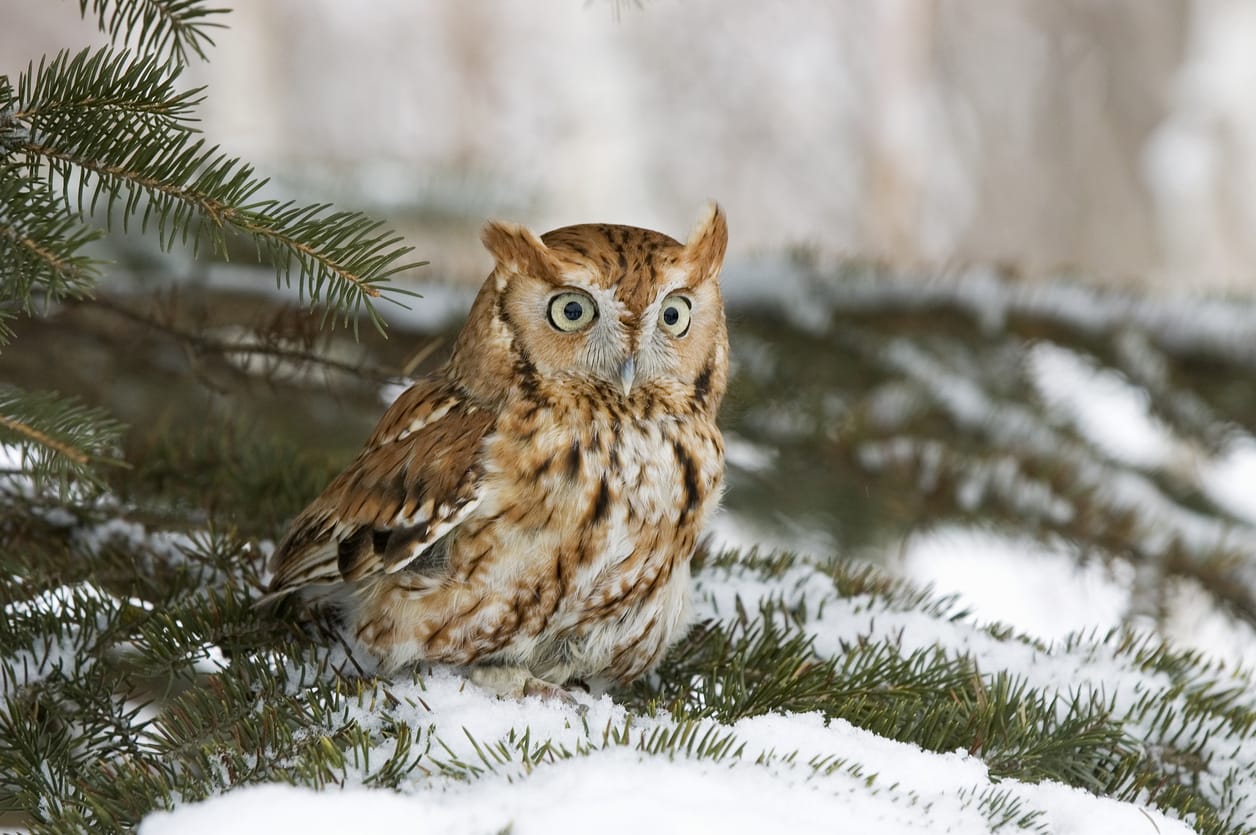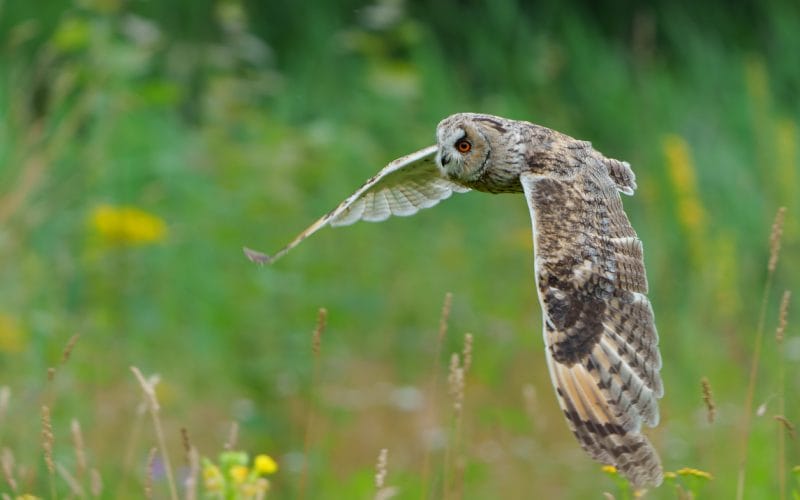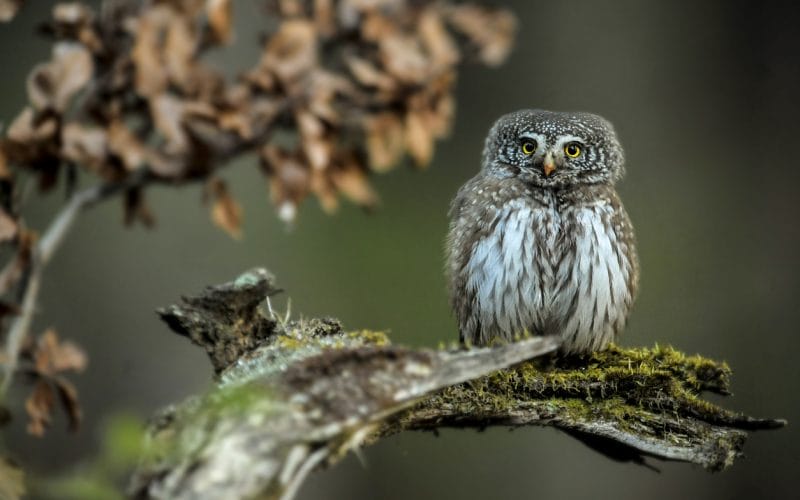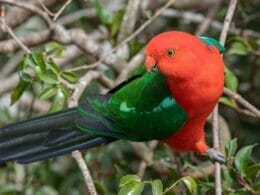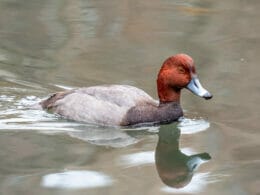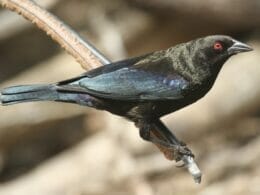Birdwatching is a quickly-growing hobby across all 50 states, and Connecticut is no exception!
Recently, the term “owling” rose to our attention, and it actually makes a lot of sense to sub-categorize birdwatching.
If you’re looking to expand your sightings, you might be interested in getting familiar with the common owls in Connecticut.
In this post, we go over some of the owls that you can come across in different landscapes and varying times of the year.
9 Magical Owls in Connecticut to Spot in the Nutmeg State
Some of these birds require you to lurk into the night, while others are fairly easy to spot during the daytime.
Take your pick, get your cameras ready, and let’s identify some owls!
1. The Barred Owl

- Scientific name: Strix varia, fam. Strigidae
- Length: 21 in
- Wingspan: 43 in
- Weight: 0.5 lb
Strix varia species have rounded heads without any noticeable ear tufts, and their faces look like layers of creamy white and brown hearts on top of each other.
People often confuse both the Barred and the Spotted species. If you’re in Connecticut, odds are what you’re seeing is a Barred one.
However, if you’d still like to know the difference, you can check their chest pattern to see whether it’s horizontally striped or spotted.
Plus, their hooting sound is very unique, and it’s almost a distinguishing feature. They usually hoot at night, but on rare occasions, you might hear it during the daylight.
Here’s the best part:
The Barred Owls aren’t migratory, and thus, you find them all year-round. In fact, they’re one of the most common owls in Connecticut!
We recommend looking in mature forests, where they find cavities for nesting in pine, spruce, and fir trees.
Author Note: Their mating is more avid during the winter, especially from December to March. If you’re lucky, you might even spot a breeding nest!
2. The Great Horned Owl
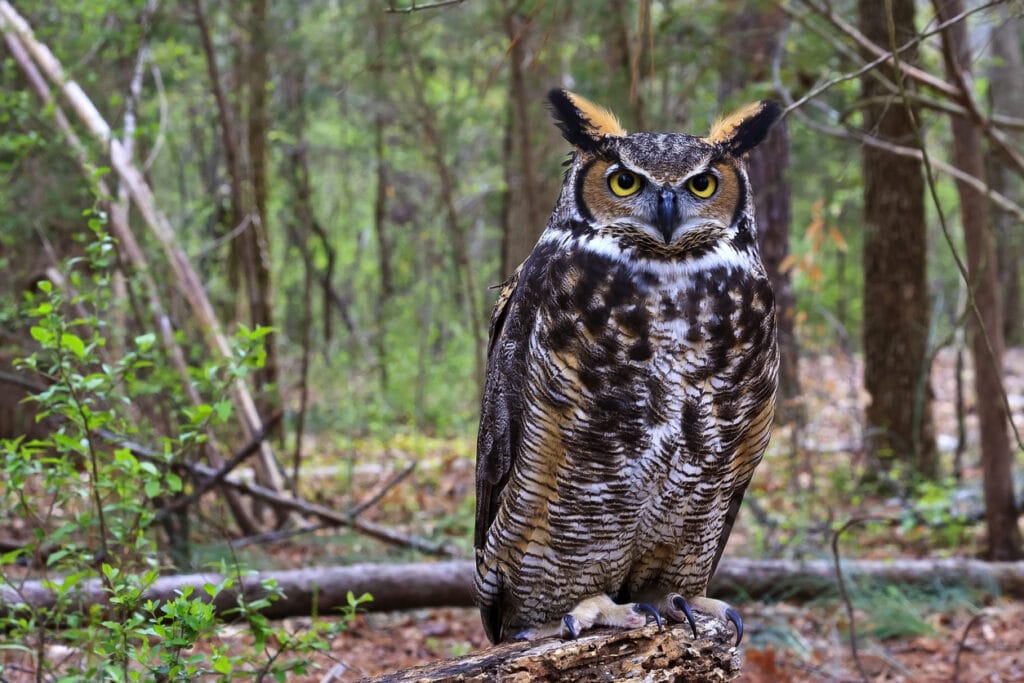
- Scientific name: Bubo virginianus, fam. Strigidae
- Length: 17-25 in
- Wingspan: 4.6 ft
- Weight: 3 lb
As you might have guessed, the Bubo virginianus has horn-like ear tufts. They’re also one of the largest species in North America, hence the name.
If you look the owl straight in the face, the tufts also look like eyebrows. Add that to the circular yellow eye, and the owl seems like it’s judging you.
As it happens, the B. virginianus isn’t a friendly species. It shows a bit of aggression, not just towards humans but also other birds.
Did you know that the Great Horned Owl is such a fierce predator that it might even hunt down other owl species?
Yes, it can attack a Barred Owl, a cat, or even a falcon without much hassle!
To make matters even more interesting, the Great Horned Owl’s poor sense of smell means that it’s not a picky eater. It’ll eat anything it can overpower, even skunks!
It shouldn’t be hard at all to spot a Great Horned Owl in Connecticut since it’s large and common enough for sightings in open fields.
Like the Barred Owls, the Bubo virginianus isn’t a migratory breed, and it only leaves its habitats if food becomes too scarce.
3. Snowy Owl
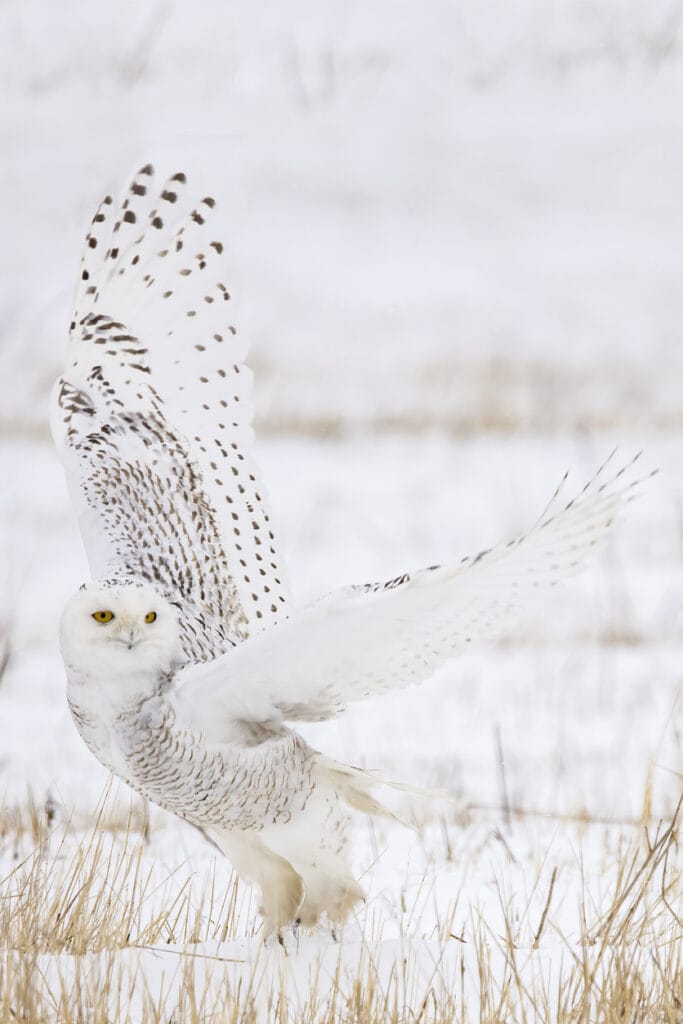
- Scientific name: Bubo scandiacus, fam. Strigidae
- Length: 24.8-28.7 in
- Wingspan: 4-5 ft
- Weight: 4.4 lb
The Snowy Owl is one of the heaviest migrating owls in North America. They’re willing to fly off to remarkable distances in search of hunting grounds.
Their migration patterns are highly dependent on habitat stability and prey abundance. Sometimes, they might even make their way down south to Florida!
Lemmings are the main part of the huge bird’s diet, but it’ll also eat voles, rodents, and even smaller birds.
Sometimes, the Bubo scandiacus is almost entirely white. Other times, it has dark spotting all over, especially female birds. Either way, it camouflages easily over snowy backgrounds.
To hide in plain sight, these white owls like cold coastline vacations!
Top Tip: To sight a Snowy Owl in Connecticut, you’ll have to wait for the winter and find a quiet spot with a lot of open space ahead.
Keep in mind that in most cases, the Snowy Owls that make it Connecticut from the North are not adult birds, and you should avoid over-socializing with them at this young age.
Unlike most owl breeds, the Bubo scandiacus avoids forests and dense trees. Instead, they’re often sighted in off-track meadows, beaches, and empty parking lots.
4. The Barn Owl
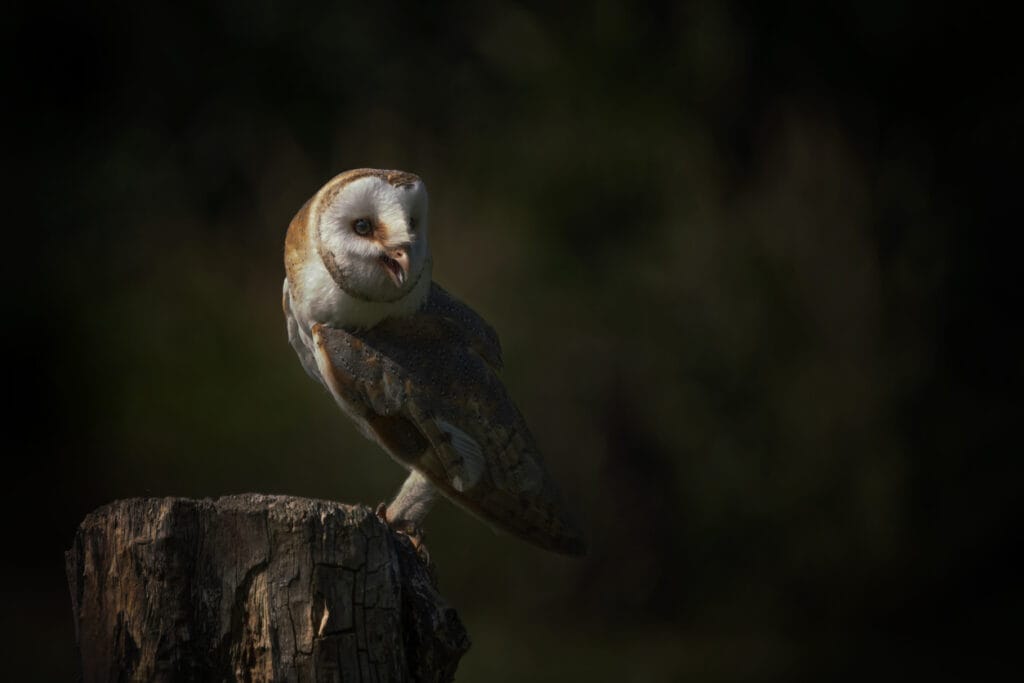
- Scientific name: Tyto alba, fam. Tytonidae
- Length: 12.6-15.7 in
- Wingspan: 42.1-43.31 in
- Weight: 1.375 lb
The Ghost Owl is also known as the Barn Owl, and it’s known for its screech that will send a chill up your spine.
They’re also often called the “silent predators of the night” because of how gracefully they can sneak up on their prey.
Their lopsided ears give them an excellent advantage at locating other animals even in total darkness, which is great considering how the species is strictly nocturnal!
You might be surprised to know that the Tyto alba is a monogamous owl, at least as long as both owls are alive.
Unfortunately, the Barn Owl is an endangered species in Connecticut.
Loss of habitat to deforestation and climate change is one of the factors that is leading to a rapid decline in the bird’s population.
Plus, the overuse of pesticides and rodenticides is increasing the risk to the Tyto alba species’ existence.
Yet, you still have a chance at spotting the Barn Owl in small farms and grasslands around Middletown, Stratford, and Winsted.
5. The Short-eared Owl

- Scientific name: Asio flammeus, fam. Strigidae
- Length: 13-17 in
- Wingspan: 35-40 in
- Weight: 0.45-1.04 lb
The Short-eared Owl is a migratory bird common in almost all continents. In North America, it makes its way through the southern coastline during the winter.
If you look at a Short-eared Owl in the face, not only does its head seem perfectly round with a white border, but it also looks like it has a creamy white “X” marked between its yellow eyes.
As the name implies, this bird’s ear tufts are barely visible from most angles, which adds to the roundness of the oversized head.
When the bird is particularly excited, the ear tufts become slightly more prominent but still nowhere near the Bubo virginianus or the Asio otus.
Overall, there’s an uncanny facial resemblance between the Asio flammeus and a moth.
Although the Short-eared Owls used to breed around the Connecticut River Valley, now they’re just wintering birds visiting the open country.
You don’t have to lurk at night to spot one of those owls since they sometimes hunt at dawn or during the early mornings.
Plus, they often frequent the same meadows, grasslands, and marshes. So, if you’re lucky enough to come across a Short-eared Owl, try re-visiting the same place for a second sighting!
6. The Long-eared Owl

- Scientific name: Asio otus, fam. Strigidae
- Length: 14-16 in
- Wingspan: 35-39 in
- Weight: 0.55 lb
If we consider the Asio flammeus a Short-Eared Owl, then the Asio otus is the Long-Eared counterpart.
Top Tip: The elongated ear tufts, along with the wide eyes give this owl a constant look of surprise on their faces, but it also helps scare predators away.
However, this particular species also goes by several names, including the Cat Owl, thanks to its triangular facial features.
It even has a rigid posture with erect ear tufts and a hyper-fixating stare that mimics housecat a lot.
Astonishingly, their hoot is somewhere between a whistle and a cat meow!
Much like the Short-eared Owl, it’s hard to spot the Asio otus in dense cities. You need to get to the coastline from November to April.
Silver Sands State Park is usually a good place to start looking for wintering owls in Milford, Connecticut.
7. The Screech-Owls
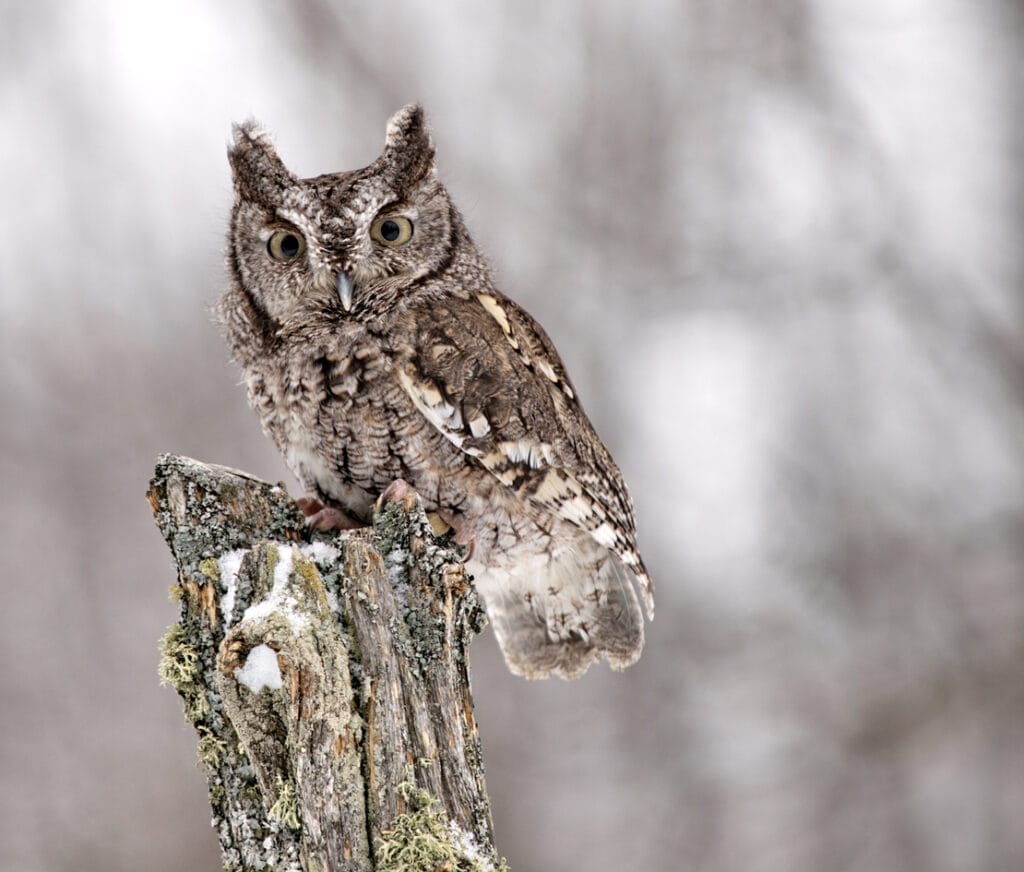
- Scientific name: Megascops asio or Otus asio, fam. Strigidae
- Length: 7.5 in
- Wingspan: 18-24 in
- Weight: 0.35 lb
Since the Eastern Screech species is smaller than other owls, its diet is mainly centered around smaller insects and worms.
Although the bird is small in size, its body is considered stocky when compared to the small head on a very short neck.
Unlike other owls, the tufts on top of the Screech’s head don’t serve auditory functions, but help in communication.
However, they’re still a vocal species. Ironically, they don’t screech, but produce a soft, almost mournful hoot, instead.
The Eastern Screech-Owl can either have a fiery-red plumage or follow a more gray tone.
Either way, both colors habit mountainous regions in Connecticut all year-round. You might find them in urban parks with a nearby water fountain.
They’re friendly and don’t shy away easily from human interaction. In fact, they might even nest around residential areas if they feel safe enough.
Typically, they don’t create their own breeding nests, but they use empty cavities in the tree barks.
8. The Saw-whet Owl
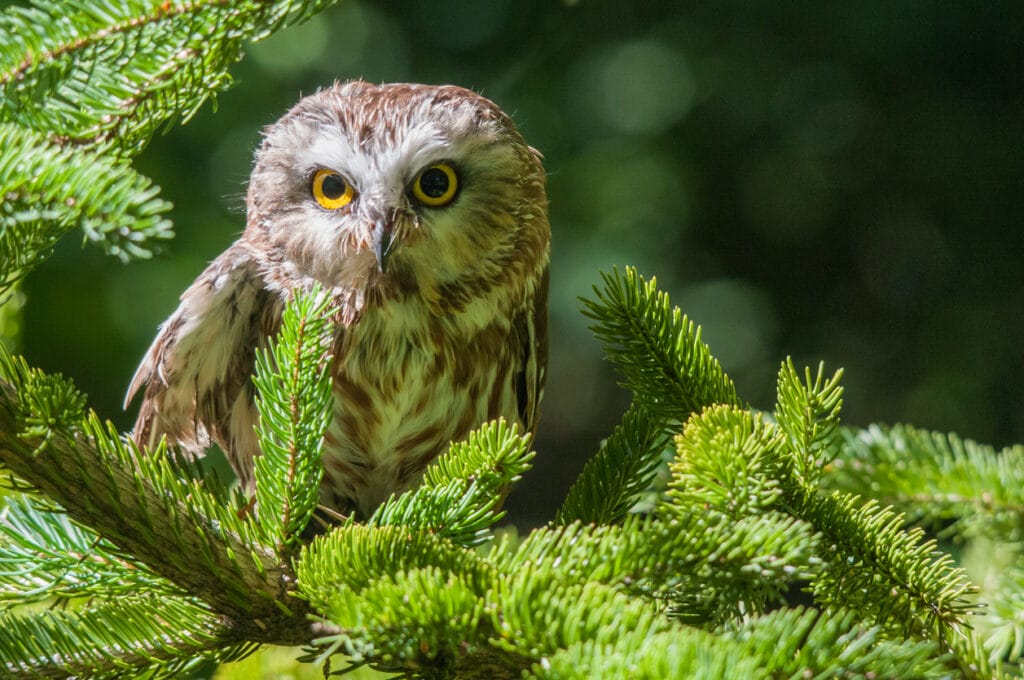
- Scientific name: Aegolius acadicus, fam. Strigidae
- Length: 7.5 in
- Wingspan: 16.5-19 in
- Weight: 0.14-0.33 lb
The Saw-whet is, hands down, one of the smallest owls you can spot in North America. Plus, it has an almost comical proportion with an oversized head, small neck, and wide glossy eyes.
Despite how welcoming and cartoonish it may look, we highly recommend against approaching a Saw-whet. It’s still a wild bird that could attack you to defend its territory!
Author Note: While trained professionals often handle these tiny owls to mark them safely, it’s not something we advise bird watchers to try.
Northern Saw-whets are creatures of the forest, where they hunt mice, voles, baby squirrels, and large insects.
The good news here is that the Aegolius acadicus population in Connecticut is stable!
These owls reside in Connecticut all year-round, and they’re fairly common around Fairfield County and Hammonasset Beach.
However, they might be a bit hard to spot because of their small size and bark-colored plumage. You’ll have to follow the shrill hoot to track them down.
Although they’re pretty small, their repetitive hoots can be heard half a mile away. So, if there’s an adult Saw-Whet around you, it’ll be hard to miss its song!
9. The Burrowing Owl

- Scientific name: Athene cunicularia, fam. Strigidae
- Length: 7.5-10 in
- Wingspan: 10 in
- Weight: 0.33 lb
This bird breaks so many norms that we expect of owls. It doesn’t perch on tree branches or hide inside woodpecker cavities!
Since the Burrowing Owl nests underground, it has no use for dense forests. That’s why it usually prefers living in grasslands, prairies, and desert-like open country.
Their underground nesting habit isn’t the only unique thing about the Athene cunicularia species. It’s also known for its long, bare legs and nod-like motion.
Living on ground level, these owls help control the population of several insects, rodents, and even squirrels.
Unfortunately, it’s not easy to spot a Burrowing Owl in Connecticut anymore.
Although they’re more common in Florida, you might still get lucky in quiet and open spaces with short grass or bare soil.
You don’t even have to wait for the nighttime since these owls aren’t strictly nocturnal. They get active during the day, especially during their breeding season from mid-February to mid-July.
The breeding season is also a nice chance to see them in flight as they perform a courtship dance-like routine to attract partners.
Final Thoughts
While many owl populations are declining worldwide, you can still find plenty of owls in Connecticut.
All you need to do is know what birds prefer a certain landscape and what they sound like. After you hear that unique hoot, you can go from there and track down the owl.
Just remember to keep your distance and respect the sanctity of wildlife!
You can always appreciate nature from a safe distance.
FAQ
To find out where recent sightings of owls have been, try eBird. You can search for the latest sightings or particular species or what has been seen in a certain area.
The Great Horned Owl is probably the most common owl in Connecticut and surely the easiest to spot!
Hammonasset Beach State Park, Stratford Point are 2 great places to see a number of owl species in Conecticut.




